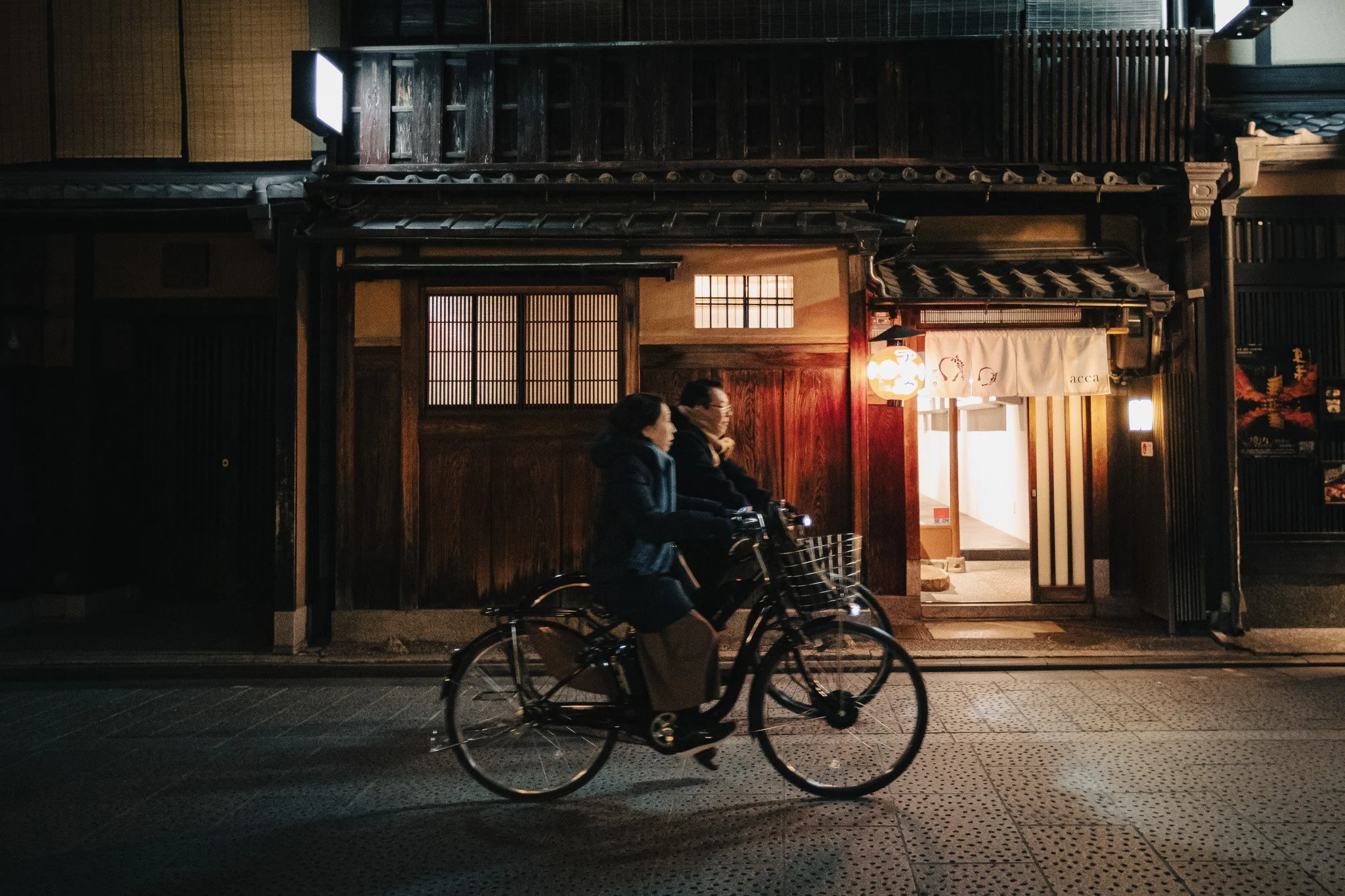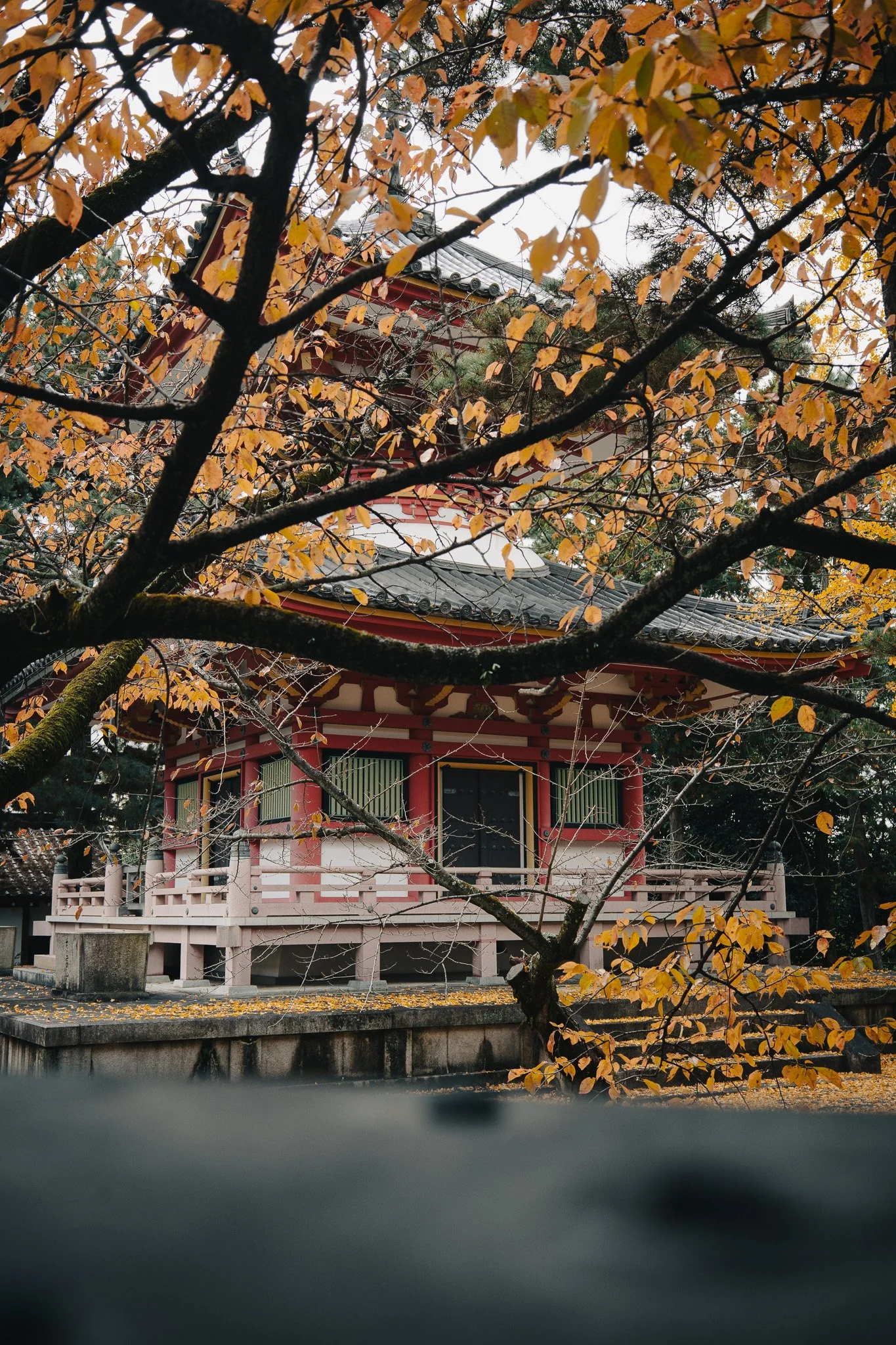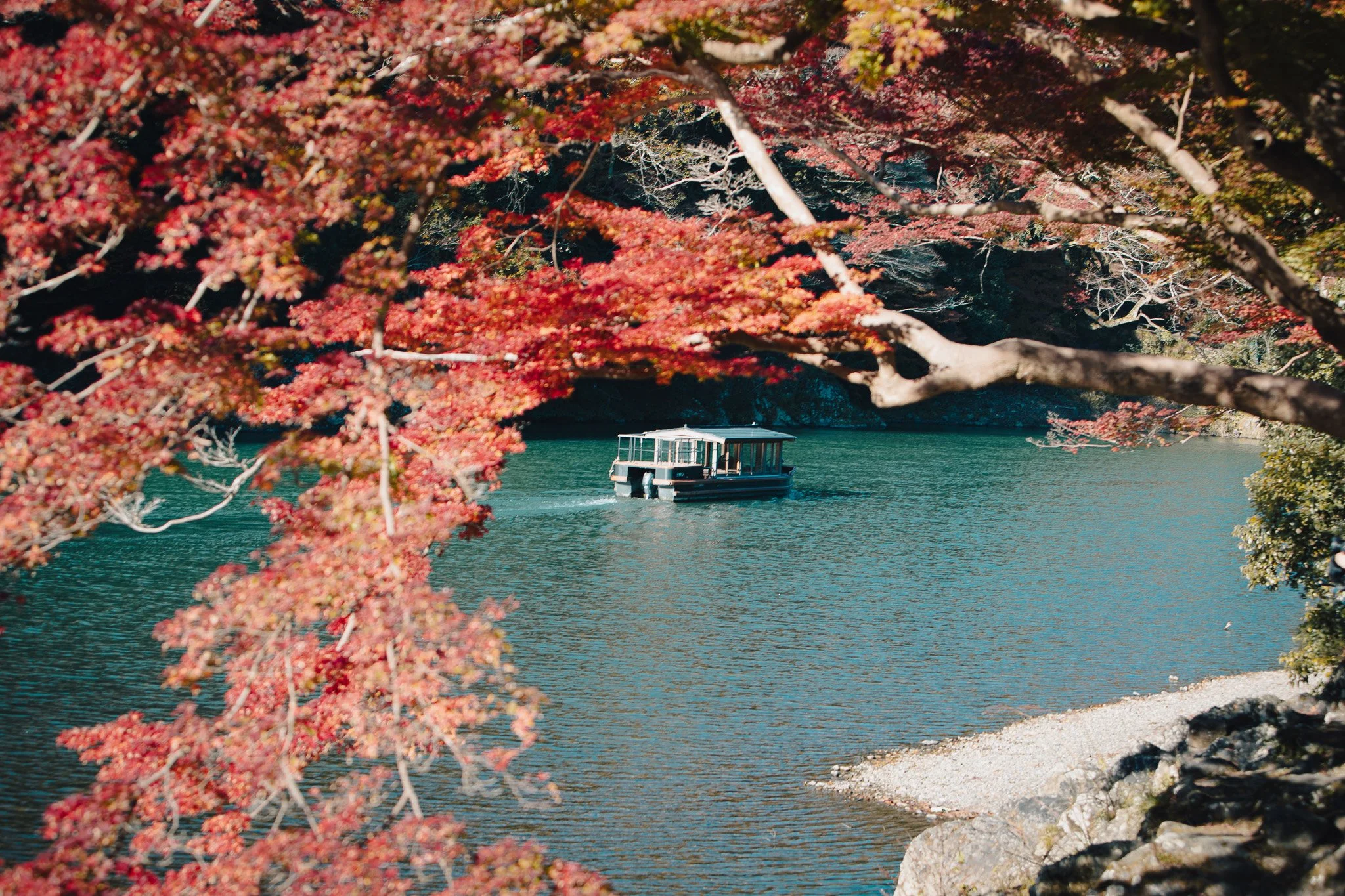Kyoto – Layers of the Sacred: Stillness, Detours & the Spirit of the City
Part 4 of 5 — like a scroll slowly unfolding, Kyoto revealed its quiet beauty through sacred moments and unexpected grace.
THE FIRST IMPRESSION
Our autumn adventure in Japan continued with fun experience on the Shinkansen from Tokyo and the excitement of Mt. Fuji showing us its snowy peak once again, which felt like a real treat and privilege!
Our visit to Kyoto started off a little bumpy.
In the late afternoon, we headed straight for Gion in search of the most anticipated, most authentic cultural experience of Japan. Or so we thought.
At first, we found little of it there. Endless crowds of tourists rivalled even Tokyo’s rush hour. Most streets were marked as private, with no photography allowed. Tea houses and restaurants were by invitation or membership only. Everything was so manicured, it didn’t seem real — it resembled a movie set.
A little overwhelmed and somewhat confused, we wandered further away from the busy areas and into a web of smaller side streets.
There were just a few people who ventured the same way. For a while, we wandered around those sparsely lit streets. Old, low wooden houses lined them quietly. The atmosphere felt much more authentic.
It was a cold night, and the orange glow from the occasional small restaurant or bar felt even more inviting.
We caught a glimpse of just a few real working geiko, and only one Japanese lady in a pale kimono, who appeared like a fleeting apparition — barely caught on camera. Taxis came straight to the houses where they lived, and within seconds they stepped out one door just to slip into another, off to their nightly appointments.
Those brief moments, caught only by the physical eye, felt magical — as if we were peeking under the veil of a secretive life we would never truly access.
People rode their bikes through the quiet of the streets. Eventually reaching their destinations, they parked outside and stepped into the warm autumnal glow of their homes, leaving the bustle of the city behind.
If Gion appeared busy to us, we would learn the next day that it wasn’t the limit.
FINDING STILLNESS
Arriving at the famous Fushimi Inari-taisha (伏見稲荷大社) shrine early in the morning left us startled. It was impossible to see where one was going behind the hundreds of people.
It felt overwhelming — and painful to witness — as it was clear that not everyone understood the reverence such a sacred place deserved. We turned away, deciding to return another time.
We strolled through nearby residential streets and came across a few quiet temples tucked safely away from all the madness. Families and friends came in and out of the gates, dressed for the occasion, paying their respects with calm and joy — a kind of quiet happiness we truly only encountered in Japan.
We reached another of Kyoto’s famous temples: Tōfuku-ji (東福寺).
We climbed a very old and steep staircase to the observatory. The structure was monumental. It made one feel really small — but in a good way. In awe of the craftsmanship and mastery that went into building it, and of those who have kept it in pristine shape all these centuries past.
It still stands big and strong, towering over those who came before us, and will continue watching over those who come after.
Exploring the temple grounds further, we came upon a small Sunday market selling beautiful pottery and traditional foods. People sat down in the sun, enjoying peaceful moments before the new workweek swept them away.
We came across a Zen garden — completely empty. It felt like a little piece of heaven on Earth.
Birdsong filled the air, and sunlight filtered through gaps in the autumn-coloured trees. It felt surreal in its simple beauty. The contrast between the lush green moss and fallen bright leaves — red, yellow, and orange — left a permanent impression.
As we were leaving, an elderly Japanese man approached us and offered two small origami cranes. He didn’t say a word, just smiled, bowed, and walked away.
An unexpected, heart-melting act of kindness in the most peaceful of surroundings.
MORNING WONDERS
We returned to Gion the next day — this time early in the morning.
To our surprise, there were already quite a few people around. Still, the streets were quieter. A few locals were walking their dogs or tending to plants outside.
Our destination was the Kiyomizu-dera Temple (清水寺).
It was breathtaking — standing tall, overlooking the city with pride and grace. It was still early in the day, and the sun hadn’t yet risen above the mountain beside the temple, casting a moody, somewhat eerie atmosphere.
The weathered temple gates, like wrinkles on the face of an old wise man, reminded us of the temple’s age. A few monks moved around the grounds.
One elderly man caught our attention. He was carefully clearing fallen leaves and re-arranging gravel with a quiet dignity, as if each leaf were the most fragile thing on Earth. He radiated calm and peace. Such contrast to the endless rushing of modern life.
Among the trees, at the far southern end of the grounds, stood the Koyasu Pagoda. A lone structure framed by the colours of autumn — reds, yellows, and greens.
Though not yet in full swing, the season had clearly arrived. The view was so picturesque, so immersive, that time itself seemed to pause. People stopped and stood still, admiring the view from the platform. There was nowhere to rush to, nothing else that really mattered in that moment. Just being.
Below, through the branches, a few figures strolled casually, seemingly reluctant to end their visit.
A light rain fell, and as the skies opened to reveal a brilliant morning blue, a rainbow arched across the cityscape.
A girl in a beautiful red kimono posed for a photo. Her presence felt so natural — as if she belonged to the centuries past. Like a scene from an ukiyo-e print come to life.
Leaving the temple, we looked back at the main pagoda, its vermilion and white structure glowing in the morning light — framed by the vibrant reds of the trees. A final, unforgettable image.
At the Chion-in Temple (知恩院) — the Monastery of Gratitude — we found a moment of pure tranquility. Almost no one was around.
The grand wooden structures made us feel small — yet also part of the landscape. The quiet magnificence of the place moved everyone to whisper or drift silently, fully immersed in the atmosphere.
A foreign girl dressed in a pale kimono caught our eye as she wandered the grounds. The whites and soft blues of her attire, combined with her fair complexion, created an almost ghostly presence — both haunting and beautiful. The softness of her appearance contrasted vividly with the rich colours of the surrounding trees.
Our last stop in the area was Maruyama Park (円山公園).
The weeping cherry trees stood bare, patiently awaiting spring. All around the park, young women and couples in traditional kimonos took photos against the leafy autumn backdrop. The clouds parted, and sunlight illuminated a particular woman standing with her back to us, gazing out over a small lake. The light touched her pastel kimono and umbrella so softly, it was like looking at yet another living ukiyo-e painting.
NIGHTTIME MAGIC
Returning to Fushimi Inari-taisha after nightfall was the best decision we made.
It’s hard to put into words — it was simply magical.
Without the suffocating crowds, the shrine came alive in its natural, divine presence. Monkeys swung through the trees, exchanging occasional cries. A wild boar darted between shrubs on the other side of the stream. Cats emerged from the shadows, meowing and cautiously seeking attention.
The path of endless torii gates, lit from both sides, cast ever-shifting patterns of light and shadow. The sacredness of the place wrapped around us like the warmest blanket on that cold November night…
RETREAT INTO NATURE
Our Kyoto journey ended in Arashiyama (嵐山) — the Storm Mountain. On a crisp, sunny morning, it revealed itself in all its natural splendour.
Around the shrines, monks cleared paths of fallen leaves, so focused they hardly noticed the people passing by.
White clouds clung lazily to mountaintops, as if reluctant to wake up. The rising sun painted them in gold.
Down by the river, men chatted as they prepared their small boats for the day ahead — ready to guide visitors up and down the shallow waters with their long bamboo poles.
The river was a stunning turquoise in places, framed by the fiery colours of autumn.
It felt like something from a dream — or a masterpiece painted by one of the world’s great artists.
Kyoto unfolded like a layered scroll — sometimes quiet, sometimes overwhelming, always unforgettable.
There’s a beauty in arriving with expectations and leaving with something entirely different: unexpected stillness, a smile from a stranger, a crane folded in silence, or a glimpse of sacredness beyond the reach of words.
Have you ever been somewhere that slowly revealed its true self — not at first glance, but when you least expected it?
We’d love to hear your stories or quiet moments that stayed with you. Come connect with us over on Substack to continue the conversation.
Next stop: Osaka — a city that surprised us in more ways than one. Come along.








